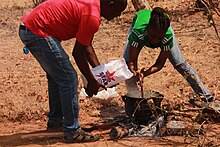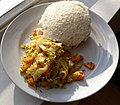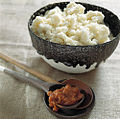Ugali ní Zimbabwe
Ugali ní orílẹ̀-èdè Zimbabwe

Sadza ní Shona tàbí Isitshwala ní isiNdebele jẹ́ oúnjẹ tí a se láti ara àgbàdo ní orílẹ̀-èdè Zimbabwe.[1]
Sadza jẹ́ èyí tí a ṣe láti àgbàdo gbígbé tí ojú rẹ̀ dára (mealie-meal). Oúnjẹ àgbàdo yìí ni à ń pè ní impuphu ní Ndebele tàbí hupfu ní Shona. Bí ó tilẹ̀ jẹ́ pé wọ́n mú àgbàdo wá sí orílẹ̀-èdè Zimbabwe (c. 1890), ó ti wá di olórí ohun èlò fún oúnjẹ àwọn ènìyàn agbègbè ibẹ̀. Àwọn ènìyàn a máa ra oúnjẹ yìí tàbí kí wọ́n sè é fúnra wọn.
Àwọn ọmọ orílẹ̀-èdè Zimbabwe fẹ́ràn láti máa jẹ èyí tí ó bá jẹ́ funfun. Ṣùgbọ́n nígbà ọ̀dá tí kò sí oúnjẹ ni wọ́n bẹ̀rẹ̀ sí ní jẹ èyí tí ó jẹ́ aláwọ̀ yẹ́lò tí wọ́n máa ń pè ní "Kenya", nítorí pé láti orílẹ̀-èdè Kenya ni wọ́n ti mú un wá. Ṣáájú kí àgbàdo tó dé, wọn máa ń se sadza láti ara mapfunde. Ní àkókò yìí, àwọn ọ̀dọ́ ní orílẹ̀-èdè Zimbabwe féràn láti máa jẹ ìrẹsì ju sadza tàbí isitshwala.[2] Alága fún ẹgbẹ́ (The Grain Millers Association of Zimbabwe (GMAZ), Tafadzwa Musarara sọ nínú ọ̀rọ̀ rẹ̀ pé bí ó bá di ọjọ́ iwájú àwọn òṣìṣẹ́ kò ní fi bẹ́ẹ̀ máa jẹ sadza sí bí wọn yóò ṣe máa jẹ ìrẹsì àti búrẹ́dì.[3]
Sadza jẹ́ oúnjẹ tí ẹnì kọ̀ọ̀kan máa ń dá jẹ, ṣùgbọ́n ní ìbẹ̀rẹ̀ pẹ̀pẹ̀ inú àwo ńlá kan ni gbogbo àwọn ẹbí yóò ti máa jẹ oúnjẹ yìí, àṣà tí àwọn ìdílé kan sì ń ṣe pẹ̀lú. Ọwọ́ ọ̀tún ni wọ́n sáábà máa ń lò láti fi jẹ oúnjẹ yìí láì lo àwọn ohun èlò tí a fi máa ń jẹun, onírúurú ọbẹ̀ àti ẹ̀fọ́ ni wọ́n fi máa ń jẹ sadza.[4]
Àwọn oúnjẹ tí ó gbajúmọ̀ tí a máa ń jẹ pẹ̀lú sadza ni ìwọ̀nyí:
Ẹran èyí tí a tún ń pè ní nyama ní Shona.
- Red meat – ẹran màálù, mutton, ẹran ewúrẹ́ àti ẹran ìgbẹ́
- ẹsẹ̀ màálù – mazondo, amanqgina
- Oxtail
- lára àwọn oúnjẹ mìíràn ni a ti rí ìfun ẹran, offal, zvemukati ( mathumbu, maphaphu, isibindi, utwane, ulusu, umbendeni; ní Shona èyí tí a mọ̀ sí matumbu), àwọn ẹ̀fọ́ tí a mọ̀ sí Mfushwa, abbl
- White meat – huku – ẹran adìẹ, ẹja
- Ẹja (hove ní Shona), àti ẹja gbígbẹ Kapenta
- Mopane worms / madora
- Spring greens – tí a mọ̀ sí imibhid ní èdè Ndebele, muriwo ní èdè Shona
- Sugar Beans – tí a mọ̀ sí nyemba ní Shona
- Cabbage
- Derere Derere – ilá
- Cleome gynandra (ulude in Ndebele) / nyevhe ní Shona
- Pumpkin – ewé tí a mọ̀ sí muboora ní Shona
- Mílííkì ti ìbílẹ̀ (tí a mọ̀ sí amasi ní Ndebele tàbí Nguni languages ní South Africa, mukaka wakakora ní Shona, tàbí lacto
- Soya Chunks
- ọbẹ̀ àti ata
- Ox bone
Oúnjẹ tí ó fi ara jọ
[àtúnṣe | àtúnṣe àmìọ̀rọ̀]Àwọn oúnjẹ tí a wọ́n fi ara jọ sadza ni polenta láti àríwá Italy, gh'omi (ღომი) láti Georgia, àti grits ní gúúsù orílẹ̀ èdè Amẹ́ríkà.
Fufu - oúnjẹ tí a ṣe láti ara ẹ̀gẹ́ èyí tí a le rí ní apá ìwọ̀-oòrùn àti ààrin gbùngbùn ilẹ̀ Áfíríkà, bẹ́ẹ̀ ni a le ṣe é láti ara àgbàdo, tí wọ́n ti máa ń pè é ní fufu àgbàdo. Ní ààrin àwọn Caribbean, àwọn oúnjẹ tí wọ́n fara pẹ́ ẹ ni cou-cou (Barbados), funchi (Curaçao and Aruba), àti funjie. Wọ́n mọ̀ ọ́n sí funche nínú oúnjẹ àwọn Puerto Rican àti mayi moulin ní oúnjẹ àwọn Haitian.[5]
Àwọn oúnjẹ tí wọ́n fi ara jọ pap mi: banku, isidudu, àti umngqusho.[citation needed]
Àwọn àwòrán
[àtúnṣe | àtúnṣe àmìọ̀rọ̀]-
Ugali and cabbage
-
Phutu, pictured with tomato-based relish in the foreground
-
A meal of sadza (right), greens, and goat offal. The goat's small intestines are wrapped around small pieces of large intestines before cooking.
-
Ugali and usipa (small fish), staples of the Yawo people of the African Great Lakes
Wò pẹ̀lú
[àtúnṣe | àtúnṣe àmìọ̀rọ̀]- Chapati
- Cornmeal
- Fufu
- Grits
- List of African dishes
- List of maize dishes
- List of porridges
- List of soups
- Malawian cuisine
- Moin moin
- Mămăliga
- Polenta
- Tuareg food
Àwọn Ìtọ́kasí
[àtúnṣe | àtúnṣe àmìọ̀rọ̀]Citations
[àtúnṣe | àtúnṣe àmìọ̀rọ̀]- ↑ "Traditional Plain Zimbabwean Sadza Recipe". Ethnic Foods R Us (in Èdè Gẹ̀ẹ́sì). Retrieved 2020-05-24.
- ↑ "Students fed up with Isitshwala and cabbage – #Asakhe – CITE" (in Èdè Gẹ̀ẹ́sì). Retrieved 2024-02-24.
- ↑ "'Young Zimbabweans prefer rice to isitshwala' – #Asakhe – CITE" (in Èdè Gẹ̀ẹ́sì). Retrieved 2024-02-24.
- ↑ "Sadza". worldfood.guide.
- ↑ Kadet, Anne (July 31, 2018). "New York City's 'Little Haiti' Makes a Big Impression". Wall Street Journal. https://www.wsj.com/articles/new-york-citys-little-haiti-makes-a-big-impression-1533045601.
General and cited sources
[àtúnṣe | àtúnṣe àmìọ̀rọ̀]- McCann, James C. (2009). Stirring the Pot: A History of African Cuisine. Athens, Ohio: Ohio University Press. ISBN 9780896802728. https://books.google.com/books?id=CAhgpbXzq0oC&q=seasons+and&pg=PR4.
- South African Cuisine
- Basic phutu recipe
- What is Phuthu
Ó le kà ṣíwájú
[àtúnṣe | àtúnṣe àmìọ̀rọ̀]The following books, set in Zimbabwe, discuss the characters eating the Zimbabwean staple, sadza:
- Dangarembga, Tsitsi (1988). Nervous Conditions. Ayebia Clark Publishing. is a semi-autobiographical novel focused on the story of a Rhodesian family in post-colonial Rhodesia (present-day Zimbabwe), during the 1960s.
- In Douglas Rogers' book The Last Resort: A Memoir of Zimbabwe (September 2009), Naomi, an elderly Malawian woman whom Rogers calls "Mrs. John", brings her husband, John Muranda, the other John, John Agoneka, and Rogers bowls of warm sadza, which Rogers explains "Mrs. John" cooks daily, over a wood fire outside the Murandas' home. (Crown/Random House, LLC, ASIN: B002PXFYIS, Chapter 4, page 23).
External links
[àtúnṣe | àtúnṣe àmìọ̀rọ̀]| Wikimedia Commons ní àwọn amóunmáwòrán bíbátan mọ́: Ugali ní Zimbabwe |
- CS1 Èdè Gẹ̀ẹ́sì-language sources (en)
- Pages containing cite templates with deprecated parameters
- Articles containing Shona-language text
- All articles with unsourced statements
- Articles with unsourced statements from October 2017
- Articles with invalid date parameter in template
- Burundian cuisine
- Democratic Republic of the Congo cuisine
- Kenyan cuisine
- Maize dishes
- Malawian cuisine
- National dishes
- Porridges
- Rwandan cuisine
- South African cuisine
- Swallows (food)
- Tanzanian cuisine
- Ugandan cuisine
- Zambian cuisine
- Zimbabwean cuisine




